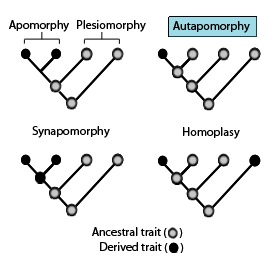Autapomorphy
Autapomorphy is a term used in the field of phylogenetics, the study of the evolutionary history and relationships among individuals or groups of organisms. An autapomorphy refers to a distinctive feature, known as a trait or character, that is unique to a given taxon. This feature differentiates the taxon from its closest relatives and its ancestral group, providing evidence of the taxon's unique evolutionary path.
Definition and Usage[edit | edit source]
In phylogenetics, distinguishing between different types of traits is crucial for reconstructing the evolutionary relationships among organisms. An autapomorphy is contrasted with synapomorphy and plesiomorphy. A synapomorphy is a trait shared by two or more taxa and their most recent common ancestor, indicative of a shared evolutionary history. A plesiomorphy is an ancestral trait shared by two or more taxa, but which is not unique to them, reflecting a more distant common ancestry.
Autapomorphies are important for identifying and classifying species or higher taxa. However, because they are unique to a single taxon, they do not provide direct information about the relationships between that taxon and others. Instead, they help in defining the taxon itself.
Examples[edit | edit source]
An example of an autapomorphy can be found in the human species, Homo sapiens. The ability to produce complex language is considered an autapomorphic trait of humans, distinguishing us from our closest relatives, the great apes.
Another example is the presence of feathers in birds. While feathers are a synapomorphy for the group that includes birds and their dinosaur ancestors, within the context of living animals, feathers are an autapomorphy of birds, distinguishing them from all other living animals.
Identification and Challenges[edit | edit source]
Identifying autapomorphies requires a comprehensive understanding of the comparative anatomy, genetics, and evolutionary history of the organisms in question. This often involves detailed phylogenetic analyses and the construction of phylogenetic trees.
One challenge in identifying autapomorphies is the potential for convergent evolution, where unrelated taxa independently evolve similar traits due to similar environmental pressures or lifestyles. Such traits may appear to be autapomorphies but are not indicative of a unique evolutionary lineage.
Implications for Evolutionary Biology[edit | edit source]
Autapomorphies have significant implications for the study of evolutionary biology. They provide insights into the unique adaptations and evolutionary paths of different taxa. By studying these unique traits, scientists can gain a deeper understanding of the processes that drive evolution, including natural selection, genetic drift, and gene flow.
Conclusion[edit | edit source]
Autapomorphies are a fundamental concept in phylogenetics, offering a window into the unique evolutionary history of a taxon. Despite the challenges in identification, they remain a critical tool for biologists in the classification and study of biodiversity.
Autapomorphy[edit | edit source]
Search WikiMD
Ad.Tired of being Overweight? Try W8MD's physician weight loss program.
Semaglutide (Ozempic / Wegovy and Tirzepatide (Mounjaro / Zepbound) available.
Advertise on WikiMD
|
WikiMD's Wellness Encyclopedia |
| Let Food Be Thy Medicine Medicine Thy Food - Hippocrates |
Translate this page: - East Asian
中文,
日本,
한국어,
South Asian
हिन्दी,
தமிழ்,
తెలుగు,
Urdu,
ಕನ್ನಡ,
Southeast Asian
Indonesian,
Vietnamese,
Thai,
မြန်မာဘာသာ,
বাংলা
European
español,
Deutsch,
français,
Greek,
português do Brasil,
polski,
română,
русский,
Nederlands,
norsk,
svenska,
suomi,
Italian
Middle Eastern & African
عربى,
Turkish,
Persian,
Hebrew,
Afrikaans,
isiZulu,
Kiswahili,
Other
Bulgarian,
Hungarian,
Czech,
Swedish,
മലയാളം,
मराठी,
ਪੰਜਾਬੀ,
ગુજરાતી,
Portuguese,
Ukrainian
Medical Disclaimer: WikiMD is not a substitute for professional medical advice. The information on WikiMD is provided as an information resource only, may be incorrect, outdated or misleading, and is not to be used or relied on for any diagnostic or treatment purposes. Please consult your health care provider before making any healthcare decisions or for guidance about a specific medical condition. WikiMD expressly disclaims responsibility, and shall have no liability, for any damages, loss, injury, or liability whatsoever suffered as a result of your reliance on the information contained in this site. By visiting this site you agree to the foregoing terms and conditions, which may from time to time be changed or supplemented by WikiMD. If you do not agree to the foregoing terms and conditions, you should not enter or use this site. See full disclaimer.
Credits:Most images are courtesy of Wikimedia commons, and templates, categories Wikipedia, licensed under CC BY SA or similar.
Contributors: Prab R. Tumpati, MD


